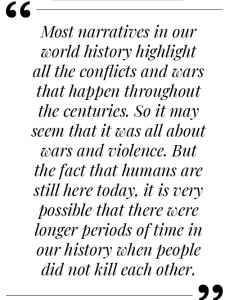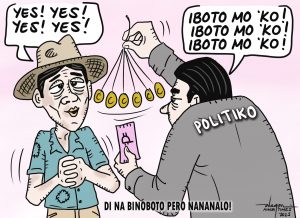 I was born in 1970 so I was a “martial law baby” in a Davao that was known as the “killing fields.” When you grew up in an environment where violence was normalized, peace was an alien concept. And when you’re raised a Filipino Catholic, you tend to believe that peace is something you can achieve only when you rest and join your Creator in heaven.
I was born in 1970 so I was a “martial law baby” in a Davao that was known as the “killing fields.” When you grew up in an environment where violence was normalized, peace was an alien concept. And when you’re raised a Filipino Catholic, you tend to believe that peace is something you can achieve only when you rest and join your Creator in heaven.
So you learn to accept violence and believe its justification. Because you do not know any other way to deal with it. But there’s always this uneasiness I feel about accepting violence as normal and justified. I do not know if it has something to do with my low pain threshold but I just cannot believe killing each other is a way to solve any problem.
Countless people have been killed in all sorts of wars throughout history yet we face the same problems that were supposed to be solved by these wars. Yes, that includes the war on drugs.
With advances in technology, killing becomes easier and more efficient. Weapons of mass destruction wipe out entire communities in seconds. Mass shootings in civilian spaces occur more often now with fully automatic guns being accessible to almost anyone who can afford them. New strains of biological pathogens can threaten our food supplies and our global ecosystem.
Glenn Paige, who wrote “Nonkilling Global Political Science,” asked: “Why when we profess to be devoted to peace, do we spend so much more on war and violence than we do on their prevention?”
As I try to make sense of all the killings and violence still happening at this so-called “Age of Intelligence,” I discovered that there is a book called “Toward a Nonkilling Paradigm.”
The book is a collection of essays edited by Joam Evans Pim on how to create a nonkilling society. It was first published in 2009 by the Center for Global Nonkilling and is free for download at http://www.nonkilling.org.
I have not yet finished reading all the essays but what I have read gave me hope. I am not foolish to think that not killing is, indeed, possible. That I am not naive to think that violence is not normal or even inevitable.
It is not true that wars cannot be avoided or that they happen by accident. As Former Director of the US Defense Threat Reduction Agency Stephen M. Younger noted in his foreword on the book: “They require the investment of billions of dollars, the most intricate planning, the creative disposition of intellectual and physical resources. Quite simply, we chose to go to war and quite often did so with enthusiasm.”
Younger, who spent most of his career engaged in national defense, including the design and maintenance of nuclear weapons, wrote in his foreword: “Each of the essays in this book offers a unique perspective, but all are united in their view that a nonkilling society is possible and that it can be achieved in a step-by-step manner, without miracles, and at a cost likely to be less than that of maintaining a massive defense establishment.”
He added that he comes from a “hard-headed recognition that our future approach to security must be different than in the past…Even the most battle-hardened soldier will know when a particular type of fight is not worth fighting, when the objective might be better achieved by other means.”
He stressed: “We are not seeking nirvana in advocating a nonkilling society, we are seeking survival. In this we can all find common cause.”
There must be something to this “nonkilling” thing if someone from the US military establishment is supporting it. It is not a new concept for it has existed in all ancient beliefs but it is gaining new advocates today.
“Nonkilling enters the 21st century not simply as a normative principle but as an approach to global problem solving based on practical applications and empirical findings,” Pim, the book’s editor, wrote.
He pointed out that in the Nonkilling History chapter, Antony Adolf and Israel Sanmartin argue that “nonkilling is also about what did not happen: individuals and communities systematically not killing each other for thousands of years, making our current existence possible.”
Most narratives in our world history highlight all the conflicts and wars that happen throughout the centuries. So it may seem that it was all about wars and violence. But the fact that humans are still here today, it is very possible that there were longer periods of time in our history when people did not kill each other.
Nonkilling and nonviolence have deep similarities and share a common background. To illustrate, Pim shared what civil rights leader and scholar Howard Thurman wrote in his 1963 essay “Disciplines of the Spirit” that explains how “nonviolence and nonkilling mean essentially the same thing” as in they both oppose the logic of hate which is to kill.
Thurman also expounded that nonviolence “may be a rejection not merely of the physical tools of violence — since their use is aimed at the destruction of human life, which is the ultimate denial of the need to be cared for — but also of the psychological tools of violence as well.”
Nonkilling is defined in the book as “the absence of killing, threats to kill, and conditions conducive to killing in human society.”
Killing is a negation principle because it means “taking the life of another person” or “fulfilling the will of the nonexistence of another” (Thurman’s term). So nonkilling is the “affirmation of the act of not taking the life of another person.”
It is a dramatic shift.
However, nonkilling is not only about the rejection of killing, but also implies constructive engagement in societal transformation.
As Paige explains: “This means unequivocal engagement in abolition of war and its weapons, abolition of poverty, nonkilling expression of human rights and responsibilities, proactive promotion of environmental sustainability, and contribution to problem-solving processes that respond to human needs and evoke infinite creative potential in individuals and humankind as a whole.”
I think it’s time we explore nonkilling as a way to solve our problems. Killing has not worked so it should not have a place in the “Age of Intelligence.” Yes, let’s be smart and make nonkilling a thing this century.


